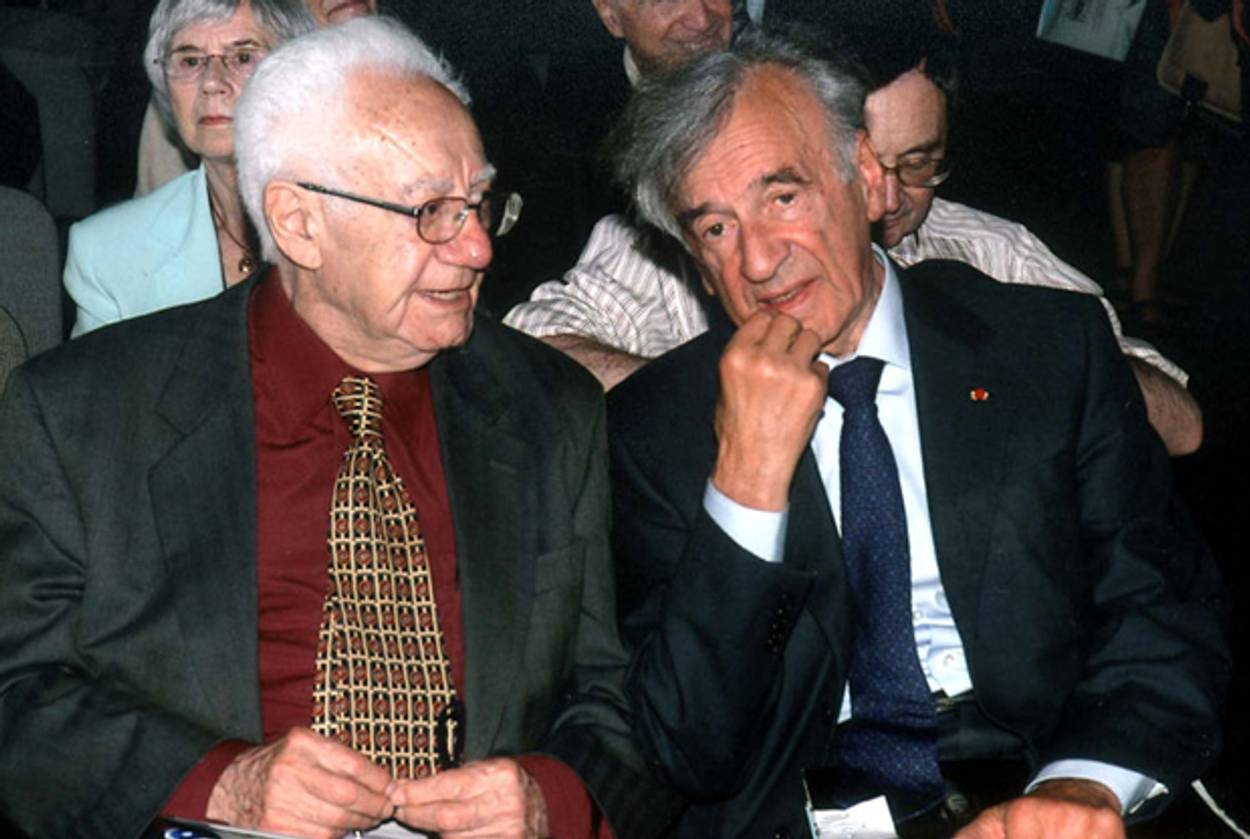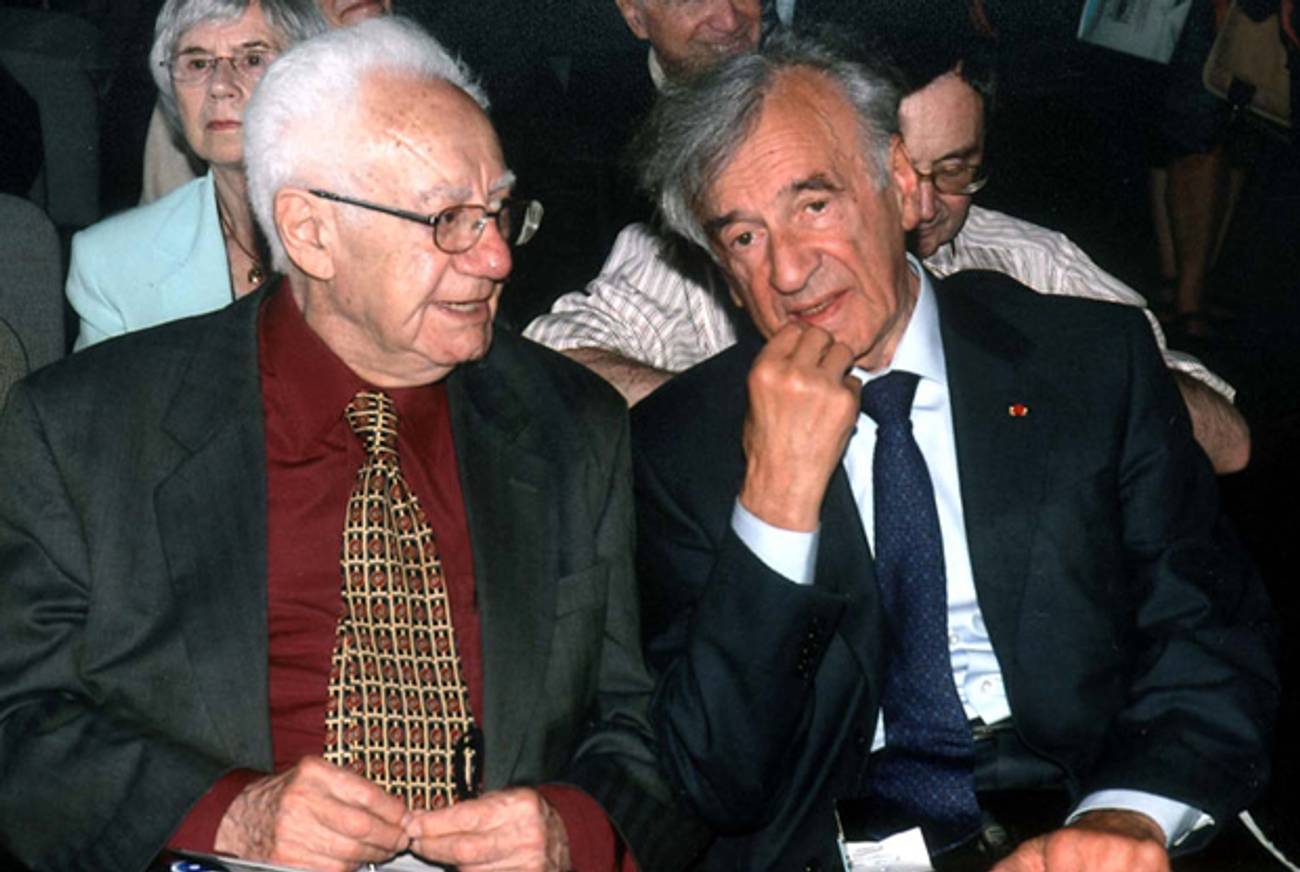Israel Gutman, Holocaust Survivor and Scholar
The longtime Yad Vashem historian died Tuesday in Jerusalem at age 90




When I asked Tel Aviv University professor David Assaf to point to the precise moment at which he pledged to devote the rest of his life to studying the Eastern European Jewish experience, he returned to 1984, when, as a 28-year-old graduate student in medieval Jewish history at the Hebrew University of Jerusalem, he participated in a trailblazing tour of Poland with leading scholars of Polish Jewry. Among the participants on this voyage were the most prominent academic researchers of Polish Jewry, including the late Yiddish experts Chone Shmeruk and Shmuel Werses, as well as Jewish folklorist Dov Noy and Israel Gutman, a renowned Holocaust scholar who fought in the Warsaw Ghetto Uprising and was later imprisoned in Majdanek, Auschwitz, and Mathausen concentration camps. Noy and Gutman both passed away this week in Jerusalem; Noy was 93 and Gutman was 90.
While the visit to Poland was an unforgettable experience that greatly influenced the rest of his professional career, Assaf recalled that “for Chone Shmeruk and Israel Gutman, the most significantly involved organizers of the tour, the experience was of a completely different nature.” He continued,
They returned, for the first time in decades, to their birthplace. The difference in approach between these two distinguished scholars was astonishing: while Shmeruk was ecstatic and filled with Polonophilic excitement, Gutman was much more reserved and cold. He was not overly impressed by the Poles or by Poland; he considered everything with suspicion and caution, and did not allow himself to fall prey to the charm of returning to Poland. This distinction also led to tension between the two figures, which exhibited itself throughout the trip and, by the way, itself served as a productive learning experience for all the participants, who were able to observe the two different personalities up-close. Even after the tour came to a close, the tension between them continued and reached its climax when Shmeruk decided to immigrate to Warsaw and even to be buried there. These two outstanding historians and scholars—both of whom were born in Warsaw and settled in Jerusalem—represented two entirely different faces of the modern Jewish condition. Every time I thought about Gutman, the Zionist, the member of Hashomer Hatzair who began his academic career at a relatively late stage, I could see in front of me the mold in which the heroes of the Warsaw Ghetto Uprising were formed. Presumably, that is exactly how Mordechai Anielewicz would have looked and sounded, had he remained alive.
Born in Warsaw, Poland in 1923, Gutman was a youth member of Ha-Shomer ha-Zair Zionist movement, and was active in the Warsaw Ghetto and fought in the Warsaw Ghetto Uprising. When he was called to testify at the Eichmann trial in Jerusalem in June 1961, Gutman stood with his sleeves rolled up and passionately described the conditions of his imprisonment at Majdanek and at Auschwitz, where he was a member of the Jewish underground, and of his death march towards Mauthausen in January 1945.
Liberated from Mauthausen in May 1945 by the U.S. Army 11th Armored Division, Gutman immigrated to Palestine in the late 1940s and raised his family on Kibbutz Lehavot ha-Bashan. He was an early leader of Holocaust commemoration in the kibbutz movement, and contributed essays on Holocaust themes to local newspapers. In 1963, he published a book, The Revolt of the Besieged: Mordechai Anielewicz and the Warsaw Ghetto Uprising.
That same year he founded and edited the journal Yalkut Moreshet, a journal of Holocaust survivors who initially found their place in Israel on the kibbutz and not the university, with contributions ranging from scholarly essays, prized archival material from personal memoirs of ex-fighters and other survivors, as well as diaries that had survived the Holocaust. As Boaz Cohen recently noted in Israeli Holocaust Research: Birth and Evolution, as a journal Yalkut Moreshet played a significant role towards “the development of Holocaust research in Israel … in providing a platform for the studies of young historians writing their seminar papers, M.A. dissertations and doctoral dissertations.”
Not satisfied with the focus of Yad Vashem, the Jerusalem museum of the Holocaust that was founded in 1953, Gutman and the other kibbutz leaders behind Yalkut Moreshet developed plans to establish institutes of commemoration and research into the study of the Warsaw Ghetto Uprising. Their plans for Bet Moreshet–Heritage House did not come to fruition, though. That’s because in June 1966, the leadership of Yad Vashem in Jerusalem began preparations to host an international scholarly conference on the 25th anniversary of the Warsaw Ghetto Uprising and other revolts of 1943, bringing together the leadership of the various survivor research organizations, including Gutman, who represented the group that published Yalkut Moreshet. As a result of those meetings, Yad Vashem decided to hold an International Symposium on Jewish Resistance in Jerusalem. After several years of planning, the opening session of the four-day conference took place in Beit Ha-Am on April 7, 1968, in the very same location as the Eichmann Trial earlier that decade, and is credited with establishing Yad Vashem’s tradition of international research conferences.
After more than two decades on the kibbutz and on the periphery of Israeli academic life, Gutman moved to Jerusalem in 1973, and in 1975 received his PhD from the Hebrew University of Jerusalem for his research on the Jews of the Warsaw Ghetto. He went on to serve as Yad Vashem’s director of research and was named the Max and Rita Haber Professor of Modern Jewish History at the Hebrew University of Jerusalem. In 1977, a Hebrew volume based on his PhD research, The Jews of Warsaw 1939-1943: Ghetto, Underground, Revolt was published. After it was translated into English in 1982, Gutman became recognized internationally as the leading Israeli Holocaust scholar.
During the 1980s, Gutman traveled around the world delivering lectures and presenting papers at scholarly conferences and publishing articles and books on a wide range of Holocaust scholarship. Of lasting significance is the four-volume Encyclopedia of the Holocaust, for which Gutman served as editor-in-chief, which is recognized as the definitive scholarly account of the Holocaust. The first volume includes an overview by Elie Wiesel and the encyclopedia’s thousand entries are written more by more than 200 scholars from around the world.
From the New York Times’ 1990 review:
The direct and unadorned prose of the encyclopedia has innumerable dramas that evoke horror and melancholy. The scope of the great annihilation emerges in the entries between the first item, ‘AB-Aktion,’ a Nazi agency whose immediate objective was ‘to suppress Polish resistance and put fear into the hearts of the Polish population by liquidating persons who were capable of inciting or organizing Polish resistance to the Germans,’ and the last article, ‘Zyklon B,’ the commercial name of the poisonous hydrogen cyanide used by the Nazis first in their euthanasia in the Nazi extermination camps, especially Auschwitz.
Upon reaching the mandatory retirement age at the Hebrew University of Jerusalem in 1993, Gutman and his colleagues at Yad Vashem established the International Institute for Holocaust Research. Gutman served as its first director until 2000, at which point he became the academic advisor to Yad Vashem, a position he held until his death this week.
Gutman’s contributions to the field of Holocaust study and role in shaping Yad Vashem’s educational mission are a lasting testament to his unceasing efforts over the past half-century to remember the victims of the Holocaust and to record their stories and experiences for all who will ever pass through the gates of Yad Vashem.
Menachem Butler, an associate editor at Tablet Magazine, is the program fellow for Jewish Law Projects at the Julis-Rabinowitz Program on Jewish and Israeli Law at the Harvard Law School, and a co-editor at the Seforim blog. Follow him on Twitter @MyShtender.